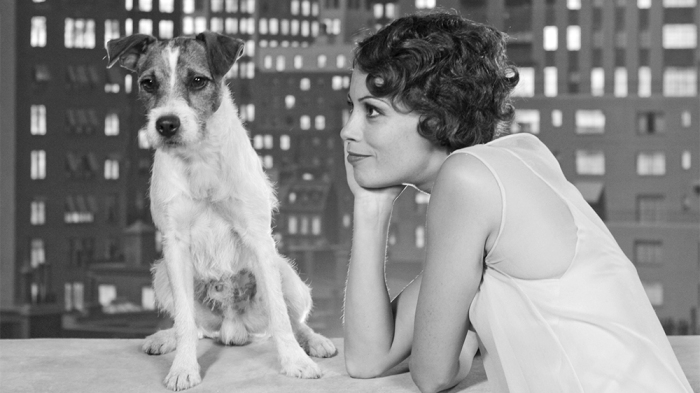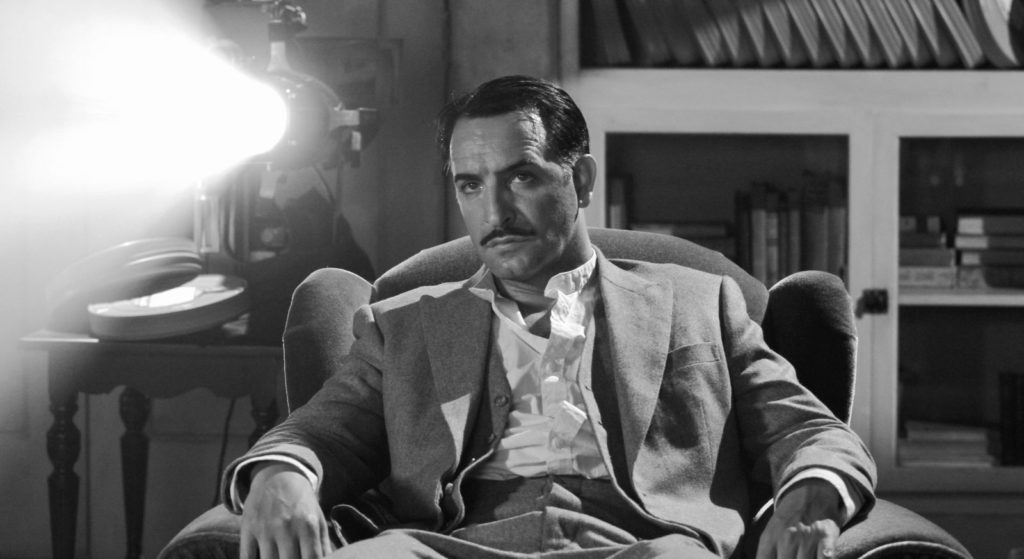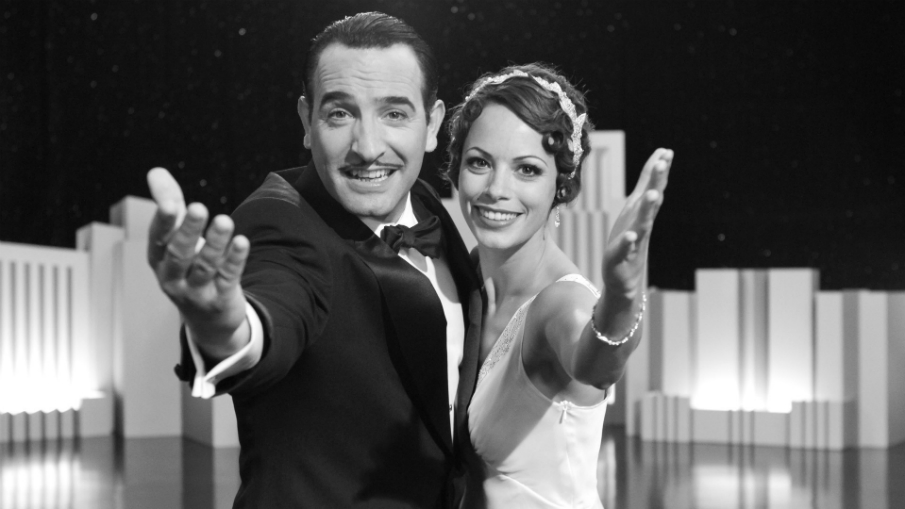The nostalgia factor extended to that year’s Oscar host. Having learned from the lackluster gamble that was James Franco and Anne Hathaway the previous year, Oscar producers enlisted an old favorite to host in 2011: Billy Crystal. This was Crystal’s ninth time hosting the show, and he was predictably snappy and entertaining in his classic old-fashioned way, down to his opening song with fine jokes about that year’s nominees.
2011 is one of the weaker Oscar years in recent history, due to the lack of truly great films in the race, very few of which hold up today. It wasn’t a big year at the box office for Oscar films or arthouse fare, with only The Help making over $100 million domestic. The Artist wound up making over $44 million when all was said and done, which is very impressive for a silent, black-and-white movie, but it wasn’t the kind of film that swept the nation by any means. However, it was unique and surprising enough that it stood out against its competition.
Let’s get into how and why The Artist cemented its place in Oscar history as the 2011 winner of Best Picture.
The Socio-Political Climate
Franchises dominated the industry in 2011, including the eighth Harry Potter film, the third Transformers, the fourth Twilight Saga and the fourth Pirates of the Caribbean. 3D was continuing its reign over the box office. Marvel and DC hadn’t quite taken over yet, but films catered to young adults were being produced like crazy, even if the results were derivative. But 2011 also showed the power of women at the box office, particularly older women. Female-led Bridesmaids and The Help were two of the biggest unexpected hits of the year, making over $169 million each.
Meanwhile, the Academy announced that their experiment of expanding the Best Picture lineup to 10 nominees in 2009 and 2010 would no longer be in effect. President of the Academy Tom Sherak announced at the time that the amount of nominees could be anywhere between five and 10, with nominees having to meet a certain threshold of votes, and stated that this gave the Best Picture honor more merit rather than filling a quota of 10. But additionally, the Academy likely changed the rule because voters previously had to vote for 10 nominees in Best Picture, and some complained that there weren’t enough films they liked to fill in all 10 slots. Personally speaking, I find it hard to believe that these Academy members are so picky that they only like five out of the hundreds of films they get to choose from, so it may come down to laziness or lack of time to watch the films, on the part of these voters.
The Campaign
The Artist premiered at the Cannes Film Festival on May 15, 2011 to rapturous audience response, with star Jean Dujardin winning Best Actor. And now we get into the uncomfortable part of The Artist‘s win, which is that the film was bought by The Weinstein Company. If there’s anything that made The Weinstein Company and specifically Harvey Weinstein powerful it’s that he was able to turn small, independent movies into Oscar-winning powerhouses. He did this through shameless campaigning to every major awards organization, and his expertise was all over The Artist‘s ultimate victory.
The Artist was featured at just about every film festival including the all-important Telluride Film Festival. Oscar buzz continued to grow for the film as more positive reviews came in and when award season properly began, The Weinstein Company executed their plan perfectly. The film includes prominent screen time for George’s (Dujardin) puppy/sidekick Jack, played by an adorable Jack Russell Terrier named Uggie, and The Weinstein Company took full advantage of his cuteness. Uggie was trotted out to every red carpet and screening there was, where he was the star of the show. And despite being predominantly French actors, Dujardin and Bejo were at all kinds of screenings in America as well.
The movie did very well at the precursors, with 11 Critics’ Choice nominations, six Golden Globe nominations, three Screen Actors Guild Award nominations and 12 BAFTA nominations. Despite The Weinstein Company casting the film as an underdog of sorts, it was anything but, and went on to earn 10 Oscar nominations, including Best Picture, Best Director for Michel Hazanavicius, Best Actor for Dujardin, Best Supporting Actress for Bejo, Best Original Screenplay, Best Art Direction, Best Cinematography, Best Costume Design, Best Film Editing and Best Original Score. It took home five wins by the end of the night, the most of any Best Picture winner this decade so far, including Best Picture, Best Director, Best Actor, Best Costume Design and Best Original Score.

The Other Nominees
The 2011 nominees for Best Picture leave a lot to be desired. Some of my favorite films of the year, including Bridesmaids, Drive, and The Girl with the Dragon Tattoo, were all in the conversation for Best Picture but none made the final list. This year features some of my least favorite Best Picture nominees this decade, with even some of the leading contenders being on the weaker end.
Chief among the worst nominees was Extremely Loud & Incredibly Close, Warner Bros. big adaptation of the bestselling book of the same name about a boy with Aspberger’s whose father dies in 9/11 and searches for a key he left behind. The film was initially buzzed due to its source material and stars Tom Hanks and Sandra Bullock, but the end result was a cloying, manipulative and filled with the worst kind of awards bait. Film bloggers were shocked when this got into Best Picture, and the big reveal is perfect in the nominations announcement. It only received one other nomination, Best Supporting Actor for Max von Sydow.
War Horse was another film maligned by many critics, though I have a soft spot for it. The Steven Spielberg-directed war epic certainly catered to Oscar voters as well and it is very sentimental, but in my opinion, endearingly so. The film earned six nominations but did not take home a single trophy.
The Help was by far the most well-known and popular Best Picture nominee of 2011, making $169 million. Some did not care for its “white savior” narrative, but the film features poignant and humorous performances by Viola Davis and Octavia Spencer, respectively, and works as a crowd-pleaser despite its difficult subject matter of racism in the Deep South. Spencer took home an Oscar in Best Supporting Actress for her performance, with the movie earning four nominations in total.
The last of the fringe contenders that didn’t have a realistic shot at Best Picture was The Tree of Life, Terrence Malick’s avant garde exploration of life’s greatest mysteries. The film, which stars Brad Pitt, Jessica Chastain and Sean Penn, was very divisive among critics and audiences, who either proclaimed it a brilliant masterpiece for the ages or a pretentious slog. I subscribe to the former rather than the latter, and it ranks as my top Best Picture nominee of the decade thus far. To this day, despite its great reviews I’m surprised the Academy went for such a challenging film, giving it three nominations.
The mid-tier contenders in the race were Midnight in Paris and Moneyball, which earned four and six nominations, respectively. Midnight in Paris, Woody Allen’s magical realism comedy about a modern man stepping into the Roaring Twenties, earned the auteur the Best Original Screenplay award. Moneyball, based on the true story of baseball coach Billy Beane (Brad Pitt) and how he turned around his Oakland team, went home empty-handed, much like War Horse.
The Descendants was one of three nominees that had a real shot at Best Picture. The movie, which tells the story of a man (George Clooney) forced to deal with family drama after his wife slips into a coma, did very little for me even though it was one of the most critically acclaimed of the year. The Descendants won the Golden Globe for Best Picture – Drama and the Drama Actor award for Clooney, and while this made it an early contender for Best Picture, it was not to be. It did, however, win Best Adapted Screenplay at the Oscars, from five nominations.
While The Descendants put up a fight, it was Martin Scorsese’s Hugo that proved to be The Artist‘s biggest competition. The 3D film, based on Brian Selznick’s book The Invention of Hugo Cabret, centers on a young boy (Asa Butterfield) who discovers a love of history and cinema. Hugo earned 11 Oscar nominations, more than any film of 2011, and also took home five trophies, tying for the most of the year with The Artist, including Best Art Direction, Best Cinematography, Best Sound Editing, Best Sound Mixing and Best Visual Effects. Scorsese was a contender for Best Director, having won the Golden Globe, though he did not win the Oscar.
The Final Vote
The Artist pulled off a major sweep heading into the Oscars, winning Best Picture – Comedy or Musical at the Golden Globes, Best Picture at the Critics’ Choice Awards, Best Film at BAFTA, Best Director at the Directors Guild of America Awards and Best Film Producer(s) at the Producers Guild of America Awards. The movie did not win Best Ensemble at the Screen Actors Guild Awards, losing to The Help, and considering it is a silent film it did not win either of the Writers Guild of America Awards (those went to Midnight in Paris and The Descendants), but it was still the clear frontrunner on Oscar night.
There was still some hope for movies like Hugo, The Descendants and even The Help to win Best Picture considering they had picked up precursor wins along the way, but The Artist was a juggernaut. The Artist had everything going for it, from its simple story that you could sit anyone down in front of and they would appreciate it to its charming leading star Jean Dujardin to that amazing dog Uggie. The film is also a love letter to the silent era of Hollywood and shows how the industry adapts in an ever-changing world. With traditional Hollywood artists feeling uneasy about the rise of 3D, motion capture technology and computer animation in the modern age, voters could directly connect with the themes present in the film.
The Best Picture nominees of 2011 clearly show an appreciation for sentimentalism, but the films were incredibly divisive. You can call The Artist a lot of things but divisive isn’t one of them, with every other film in the lineup having detractors. The Artist was clearly a big no. 1 pick for many voters, but even those who preferred more daring films like The Tree of Life or Midnight in Paris likely ranked The Artist at no. 2. It’s the movie all members of the Academy could agree was good enough, and by the the higher-ups’ standards of wanting their members happy, that is the ideal.

The Film Itself
Rewatching The Artist six years later, outside the insanity of award season, I am of two minds. For one, I don’t think the Academy did it any favors by rewarding it Best Picture. It is a perfectly decent, charming film that evokes a special time in popular culture, with expressive performances by Jean Dujardin, Bérénice Bejo and of course, Uggie. But thrusting the Best Picture title onto it builds up an expectation of transcendent greatness that the film just doesn’t live up to. This is not the movie’s fault, as such great expectations have more to do with the person watching it, but even on its own merits, I don’t know that The Artist gives the audience much to chew on in its relatively simplistic plot. This is a film about how an artist is sometimes forced to adapt to changing culture, in this case the advent of the “talkies,” which resonates in today’s times, but it doesn’t have much to say about it other than “adapt or die.”
There are some moments of real magic, like Peppy (Bejo) with George’s coat, the dream sequence and the dazzling tap dance, but the plot unfolds in such a straightforward manner that I found it difficult to be truly engaged throughout. Michel Hazanavicius has all the pieces of the silent era, having clearly done his homework, yet that “silent film” trick does most of the heavy-lifting. I will admit it was amazing watching a silent film like The Artist in a theater in 2011. Now seeing it again on a smaller screen knowing what I was getting into, the magic feels lost. Rewatching a movie is one of the most rewarding experiences in how it allows you to discover new things and examine its themes further. When you get past the thrill of seeing a silent movie in modern times, however, there’s not much left to chew on.
Will The Artist Stand the Test of Time?
When I think of the ideal Best Picture winner, I imagine a film that influenced artists that came after it, something like Casablanca, The Godfather, Midnight Cowboy or even The Lord of the Rings: The Return of the King. Or, I think of a unique artistic expression like Annie Hall, Slumdog Millionaire or Moonlight. I don’t see The Artist as fitting either criteria; while the film is somewhat unique in that it is one of only two primarily silent films to win Best Picture, the other being 1928’s Wings, there is nothing about it that feels new or exciting for its time. As a throwback to a time period from almost a century ago it certainly hasn’t influenced any new kinds of filmmaking either. We aren’t seeing any prominent silent films six years later.
In no way do I think The Artist is a bad film, despite my criticisms. Future cinephiles will surely understand The Artist considering its simplistic themes and form, but I don’t think they will understand why it was chosen as the best film of 2011. Even newer generations who came of age after The Artist‘s big win are watching it for the first time and observing, “This was very fun, but Best Picture worthy?!” When I compare The Artist to something like The Tree of Life or Hugo, there’s simply no contest.
What do you think? To watch The Artist for yourself, it is available to rent or buy on Amazon Instant Video, DVD or Blu-ray through the following links:

